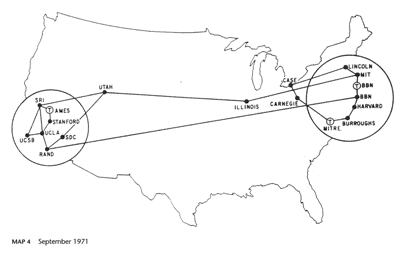Who didn't invent email?
Who didn’t invent email? Shiva Ayyadurai.
He’s not the only one – I didn’t invent email either, nor did Abraham Lincoln, Boadicea or Tim Berners-Lee. So why mention Shiva?
He claims that in 1978 when he was 14, he took some courses in programming. His mum worked for the University of Medicine and Dentistry of New Jersey, and one of her colleagues challenged him to write an electronic mail system. And he did just that, creating a basic messaging system in FORTRAN, based on the existing paper memo format, ending up with a non-networked electronic mail system with similar functionality to mainstream applications that were in use well over a decade earlier.
That’s pretty impressive, and is the sort of thing that’ll look good on a college application form. (When I was 13 I designed and implemented a chassis dynamometer management unit that Shell’s research division used to test fuel and lube oil performance over virtual driving tracks – dozens of pages of 6502 assembly code, and you can be sure I put that on my college application form).
Some years later, in 1982, Shiva applied for and was granted a certificate of copyright registration on that piece of software. A copyright is not a patent – it recognizes and protects the expression of the work, not the idea underlying the work. There’s no real bar for copyright, other than it being a piece of work you created yourself – I automatically own copyright to anything I create, including software I’ve written and this blog post. Registering a copyright on a work, whether it be software or anything else, is a trivial exercise in bureaucracy – you fill in a form, you pay a registration fee, it gets rubber stamped. What is protected by the copyright is the work – in this case the software source code – itself, not the ideas, not the name of the package, nothing else. (I have copyright on my software package, Abacus. That doesn’t mean that I invented the Abacus.)
Meanwhile, Shiva moved into email marketing, founded a small ESP, and seems to be doing quite nicely (although a journalist who looked can’t find much evidence of the ESP being successful, or even existing, other than a lawsuit it filed against IBM and American Express for misappropriation of trade secrets in 2005).
Back in 2011, though, things started to get weird. Shiva started to use this copyright filing, and the fact that he used the title “EMAIL” on the filing, to support a claim that he was “the inventor of email”. It’s a compelling human interest / tech story to journalists whose knowledge of email and internet history is vague, so it got quite a bit of coverage.
(Shiva makes an image of his copyright certificate available: http://www.vashiva.com/images/vashiva_patent3_enl.jpg. Note that the URL describes it as a “patent”, rather than a copyright filing.)
It was quickly debunked. It didn’t pass the sniff test. Technical blogs started asking how the Washington Post and other press had fallen for this. The Washington Post clarified that pretty much all the significant claims in the original article were untrue.
It didn’t go away, though. Two-and-a-half years later, there’s a series of articles in the Huffington Post, pitching the same story, this time with a few unpleasant twists in it’s approach. It’s got a glossy infographic, filled with provably false claims. It has the feel of a professional PR campaign, rather than an article written by a reporter. Sure enough, it’s written by Larry Weber, a high powered PR guy (CEO of RacepointGlobal – who “build the right influencer relationships for your brand” – and CEO of Weber Public Relations Worldwide). There are at least five article in the series, all written by different people, but having oddly similar phrasing.
Shiva’s ESP, EchoMail, and their current branding is based around his (false) claim to be the “Inventor of Email”, so there’s clearly money as well as ego at stake. Neither Larry Weber nor the Huffington Post mentioned that Larry Weber is also on the board of EchoMail.
So we’re going through the debunking process again. I was going to write more, but others are way ahead of me.
So Ayyadurai did flee, returning to MIT, where he’s generally described by his colleagues as a nut and fraud—the terms “asshole,” and “loon” were tossed around freely by professors who were happy to talk about their coworker but prefer to remain anonymous. “Don’t know him, but [he] didn’t invent email. If he claims to have done so he’s a dick,” said one MIT brain.
— Corruption, Lies, and Death Threats: The Crazy Story of the Man Who Pretended to Invent Email (Gizmodo)
When you look at the collection of articles, they all repeat the same basic things: Ayyadurai did create an email system and “it was recognized by the federal government.” This is misleading in the extreme. It’s amusing how they all use the exact same language.
— Why Is Huffington Post Running A Multi-Part Series To Promote The Lies Of A Guy Who Pretended To Invent Email? (Techdirt)
Ayyadurai has waged an incredibly bizarre public relations campaign, and the more you look at it, the more bizarre it becomes. … What I still cannot fathom is how the Huffington Post can stand behind this “reporting.” I’ve now heard from three different HuffPost reporters on the news side who all say that they’re horrified that no one at the company has done anything about this.
— Huffington Post And The View From Bogustan: Standing Behind Blatantly False Claims Isn’t Journalism (Techdirt)
Despite my requests to both Huffington Post and Larry Weber (the PR guy who kicked off the “series”), neither has responded and explained if any money is changing hands here. That means either it is, and Huffington Post is violating FTC rules concerning “paid” posts, or Huffington Post just made it clear that it is willing to post pure bullshit without the slightest bit of fact checking. I’m still not sure which is worse.
— Huffington Post Doubles Down, Has MIT Professor Spread Blatant Falsehoods About Creation Of Email (Techdirt)
Haigh details how Ayyadurai has conveniently tried to rewrite his own history to counter the debunkings. For example, in 2011, he originally claimed that while he was “challenged” to create an electronic interoffice messaging system in 1978, he didn’t actually get it to work until 1980. But, of course, by then email was much more widespread. So, Ayyadurai changed the story, and pretended that he was both challenged and wrote his “50,000 lines of code” and got it all working in 1978.
— Huffington Post Finally Responds, Stands By Its Completely Bogus, Totally Debunked ‘History Of Email’ Series (Techdirt)
There are some other conspicuous inconsistencies. The graph on page 25 suggests that around 10,000 email messages were sent in 1978. Endnote 3 cites a Huffington Post appearance of Ayyadurai’s 2011 infographic as the source, which doesn’t help much. 10,000 is, however, rather a high figure to start at and the line barely climbs over the next year. Thus if the graph is based on an actual data set it appears to have been truncated to avoid the embarrassing suggestion that email existed before 1978. On the other hand, the infographic on page 170 claims that there were zero users of email in 1978. Where did those 10,000 messages come from? Who read them?
In 1979, according to the infographic, there were just 2 users of email. The big jump, it suggests, comes between 1982 and 1983 when the population of email users explodes from 1,000 to 100,000. No explanation is given for this hundred-fold growth.
I looked again at Ayyadurai’s website again search of something that might explain the mystery. I then noticed that the online version of the infographic has recently been modified.
— Did V.A. Shiva Ayyadurai Invent Email? A Computer Historian Responds (Special Interest Group – Computers, Information and Society)
Compounding the gaffe was the glibness of Post ombudsman Patrick Pexton’s initial response to reader complaints. He found more fault with the outraged commenters than with the flawed reporting, which he defended as the heroic effort of an overworked journalist: “Could you, as Ms. Kolawole did, do all this in one day?” he wrote. “Write a story, edit seven videos, and write up a transcript of her Q&A session with Ayyadurai?”
A week later, Pexton published a more level-headed response, in which he admitted that his original post was “dismissive, snarky and wrongheaded.” Maybe he was overworked, too.
— Google it, man! (Columbia Journalism Review)

